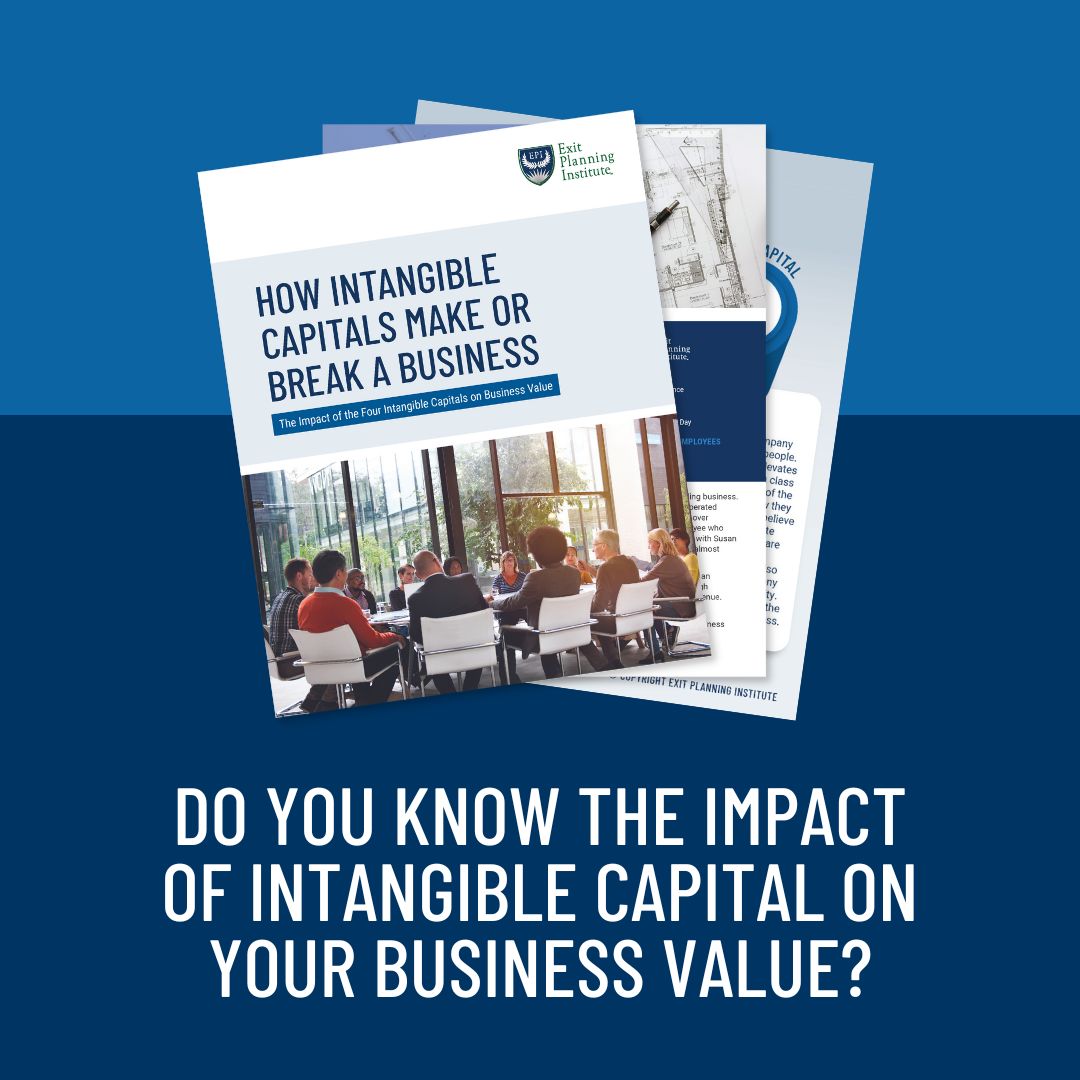
THE EXIT PLANNING BLOG
Keep up-to-date with exit planning, succession planning, industry trends, unique specialty insights, and useful content for professional advisors and business owners.
Share this
An In-Depth Look at the Four Intangible Capitals
by Colleen Kowalski on December 30, 2022

Intangible Capitals make up roughly 80% of a business’s value. Without understanding the strengths and weaknesses of the intangible capital of your business, you run the risk of leaving value on the table during your business exit. Exit Planning Institute CEO, Christopher Snider, shares, “Managing intellectual knowledge has become the single most important task of business. Today, wealth is created by your ability to create, assemble, integrate, protect, and exploit knowledge assets.”
Exit Planning Institute recently released a comprehensive look at the Four Intangible Capitals consisting of an in-depth whitepaper, owner exit case study, and descriptive infographic. We recommend these resources be utilized by advisors in client engagements, shared with your network of advisors and owners, and incorporated into your content strategy.
What Are Intangible Capitals?
Human Capital
Human Capital is the measure of the strength of your people, talent, ability to execute, ability to choose and prioritize, ability to adapt and innovate, energy and passion, personal character, grit and intelligence, and the ability to deploy these independently of the business owner.
Customer Capital
Customer Capital measures the strength of your relationships throughout your supply chain. The primary driver of customer capital is the relationships with your best customers: deep, integrated, open communication, shared goals, and benefits.
Structural Capital
Structural Capital represents the strength of your strategy, systems, processes, capital, and financial structure. How well are these documented, proven, and are they scalable and transferrable?
Social Capital
Social Capital is the strength of your culture. Human, Customer, and Structural Capitals are blended and optimized by Social Capital to create a flow and rhythm that self-perpetuates, drives and elevates your company to best-in-class.
Check out the latest Exit Planning Institute Content:
How Intangible Capitals Make or Break a Business: The Impact of the Four Intangible Capitals on Business Value
Exit Planning Institute interviewed a variety of experts to determine how these Intangible Capitals can be strengthened to improve business value. Explore the benefits of strong Intangible Capital, how to improve your Capital, and the negative impact of poor Intangible Capital strength.
The Four Intangible Capitals Infographic
We created a new graphic displaying the Four Intangible Capitals in every owner’s business. This infographic highlights the main attributes of each Intangible Capital and provides advisors and owners with a checklist for building value in each facet of their business! Chris Snider says, “Although most owners intuitively are aware of the importance of these assets, most do not formally measure them. When optimized these assets create accelerated increases in business value and owner independence.”
How Improving the Four Intangible Capitals Can Build Value In Your Business Case Study
Dan Paxton, Principal at ExitSmarts, Inc. and CEPA since 2021, shared the story of one of his client engagements dealing with weaknesses in the business’s intangible capital. In the most recent Exit Planning Institute case study, Dan walks through the path toward building transferable value in a business that is entirely dependent on the owner.
View More Exit Planning Content
Exit Planning Institute shares new research and content about various trending exit planning topics on a quarterly basis. This content provides advisors and owners with a deep dive look at the value acceleration, the four intangible capitals in every business, and personal planning considerations. Through whitepapers, case studies, and infographics, you can advance your education around these important topics and stay up to date with industry trends.
Explore our Exit Planning Content Library here.
Follow our socials for more exit planning content and strategies.
Share this
- Blog (544)
- CEPA (419)
- exit planning (249)
- CEPA community (187)
- Business Owner (170)
- Exit Planning Summit (95)
- EPI Chapter Network (89)
- Value Acceleration Methodology (79)
- Exit Planning Partner Network (76)
- EPI Announcement (49)
- Content (48)
- Webinars (37)
- Excellence in Exit Planning Awards (33)
- Marketing (30)
- 2024 Exit Planning Summit (28)
- 5 Stages of Value Maturity (26)
- Books (24)
- EPI Academy (24)
- EPI Team (22)
- Exit Planning Teams (22)
- Leadership (21)
- 2023 Exit Planning Summit (20)
- family business (20)
- women in business (19)
- Intangible Capital (18)
- Exit Options (17)
- Black Friday (16)
- CPA (15)
- Walking to Destiny (15)
- State of Owner Readiness (14)
- Chapters (13)
- Chris Snider (12)
- National Accounts (12)
- Small business (12)
- charitable intent (12)
- personal planning (12)
- Financial Advisors (11)
- Season of Deals (9)
- 5 Ds (8)
- About us (8)
- Podcast (8)
- Insiders Bash (7)
- Scott Snider (7)
- Christmas (6)
- Exit Planning Content Library (6)
- Case Studies (5)
- Owner Roundtables (5)
- Value Advisors (5)
- financial planning (5)
- Awards (4)
- Circle of Excellence (4)
- Exit & Succession (4)
- Five Ds (4)
- Three Legs of the Stool (4)
- executive training (4)
- Owners Forum (3)
- author (3)
- forbes (3)
- DriveValue (2)
- EPI Thought Leadership Council (2)
- Exit Is Now Podcast (2)
- Peter Christman (2)
- Veteran (2)
- Whitepapers (2)
- Business Owners Forum (1)
- SOOR (1)
- business consultants (1)






